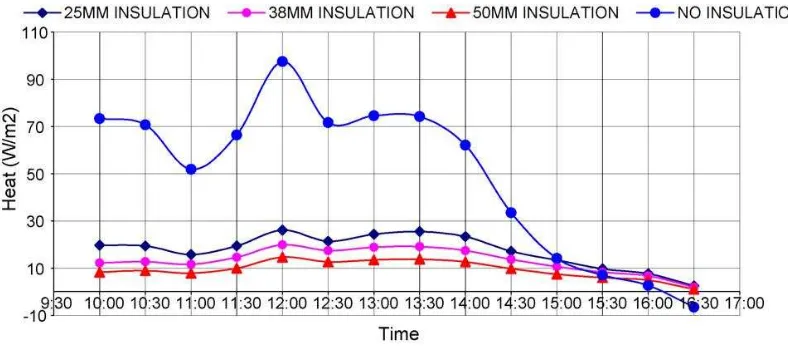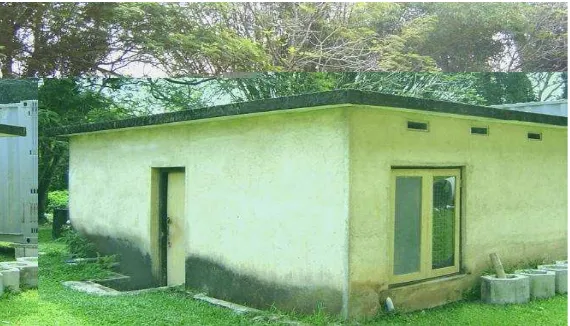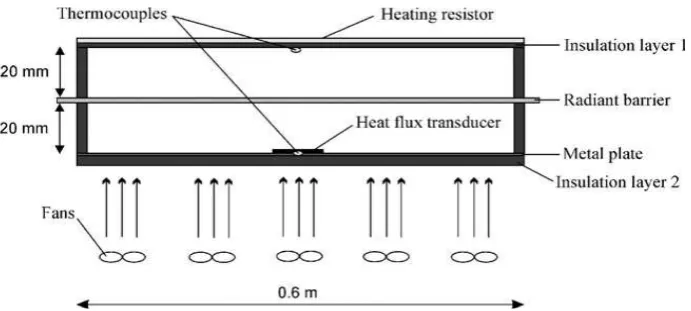APPROVAL OF SUPERVISOR
“I hearby declared that I have read through this report and I found that it has comply the partial fulfilment for awarding the degree in Bachelor of Mechanical Engineering
(Thermal Fluid)”
i
HEAT TRANSFER IN A TERRACE HOUSE WITH USING ROCK WOOL
MOHD MU’ADZ B MD ESWAN
This report is submitted as partial requirement for the completion of the Bachelor of Mechanical Engineering (Thermal Fluids) Degree Programme
Faculty of Mechanical Engineering Universiti Teknikal Malaysia Melaka
ii
DECLARATION
“I hereby, declare this thesis is result of my own research except as cited in the references”
Signature : ……….
Author Name : Mohd Mu’adz Bin Md Eswan
iii
DEDICATION
To
iv
AKNOWLEDGEMENT
First, l would like to this opportunity to express my deepest appreciation and thanks to my supervisor, Mr. Shamsul Bahari Bin Azra’ai for his supervision, encouragement, guidance during undertaking the project.
Also, I express my heartfelt thanks to Dr Mohd Yusuf Bin Sulaiman and Mr. Mohd Firdaus B Sukri for assistant, my friend Heinsen bin Jepanih, Saiffudin bin Ngspar invaluable knowledge and progressive, advices until the project completed successfully.
I would like to express thanks to all technicians and staffs from Mechanical school for their advices and response given whenever I encounter predicaments
v
ABSTRAK
Di negara-negara tropika, penyerapan haba paling besar berlaku melalui bumbung sebuah rumah. Umumnya, haba yang hilang daripada sesuatu sistem untuk persekitaran adalah pembaziran dan mempunyai kesan langsung ke atas kecekapan sistem itu. Juga untuk sistem-sistem yang wujud dijalankan sebagai sistem penyejukan, haba memperolehi daripada persekitaran akan mengurangkan kecekapan proses penyejukan. Dalam semua kes-kes ini haba dipindahkan oleh konduksi di luar permukaan dan ia kemudian dipindahkan oleh perolakan dan radiasi kepada alam sekitar. Walaupun rumah pada masa kini telah dipasang siling, bagaimanapun ia tidak begitu berkesan bagi mengurangkan haba pemindahan ke dalam rumah. Perkara ini akan menyebabkan dalam rumah memerlukan penyaman udara atau kipas untuk menyejukkan dalam rumah. Perkara ini akan menyebabkan penggunaan tenaga elektrik lebih banyak daripada yang sewajarnya. Kerugian ini telah dapat dikurangkan dengan menggunakan bahan penebat haba. Kajian ini telah dijalankan disebuah rumah teres dan menunjukkan dengan menggunakan rock wool sebagai
bahan penebat dapat menolong mengurangkan pemindahan haba didalam rumah teres sekaligus dapat mengurangkan guna elektrik untuk menyejukkan dalam rumah. Kajian ini juga telah dijalankan dengan menggunakan bahan penebat dan tanpa bahan penebat penggunaan. Setiap kajian, suhu telah diambil dan dibuat analisis diantara kajian-kajian ini untuk dibuat perbandingan. Di akhir kajian, mendapati bahawa pengaliran haba tanpa menggunakan bahan penebat hanya dapat dikurangkan sehingga 0.122 W/m2 manakala dengan menggunakan bahan penebat, pengaliran haba dapat dikurangkan sehingga 0.116 W/m2. Kesimpulanya, dengan menggunakan bahan penebat rock wool dapat menggurangkan permindaan haba ke dalam rumah
vi
ABSTRACT
vii
LIST OF CONTENTS
CHAPTER TITLE PAGE
DECLARATION ii
DEDICATION iii
ACKNOWLEDGEMENT iv
ABSTRAK v
ABSTRACT vi
LIST OF CONTENTS vii
LIST OF TABLES x
LIST OF FIGRUES xi
LIST OF SYMBOL xiii
LIST OF ABBREVIATIONS xiv
LIST OF APPENDIX xv
CHAPTER 1 INTRODUCTION 1
1.1 Background Study 1
1.2 Problem Statement 2
1.3 Objectives 2
1.4 Scope 2
1.5 Benefit 3
CHAPTER 2 LITERATURE REVIEW 4
2.1 Thermal performance of insulated
roof slabs in tropical climates 4
2.1.1. The result 4
2.1.2. The model 5
viii
2.1.4. Conclusions 7
2.2. Theoretical/experimental comparison of heat flux reduction in roofs achieved
through the use of reflective thermal insulators 7
2.2.1. Experimental apparatus 8
2.2.2. Evaluation of parameters 9
2.2.3. Conclusions 10
2.3. Insulating material 11
2.3.1. Aluminium Foil 11
2.3.2. Rock wool 12
2.3.3. Ceramic 12
2.3.4. Magnesia 13
2.3.5. Calcium silicate 13
2.3.6. Cellular glass 13
2.3.7. Glass wool 13
2.3.8. Rigid polyurethane foam 14
2.3.9. Expanded prelate 14
2.3.10. Fourier’s law of heat conduction 14
CHAPTER 3 METHODOLOGY 16
3.1 Introduction 16
3.2 Experimental set-up 17
3.3 Experiment procedure 18
3.4 Measurement equipment 20
CHAPTER 4 RESULTS AND DISCUSSION 21
4.1. Result 21
4.1.1 Temperature reading without using
rock wool 21
4.1.2 Temperature reading with using
rock wool 22
ix
4.1.4 Graph for bottom roof temperature
versus time 23
4.1.5 Graph for bottom ceiling temperature
versus time 24
4.1.6 Graph for room temperature versus time 25
4.1.7 Heat transfer result 26
4.2. Discussion 27
4.2.1 Temperature ambient versus time 27 4.2.2 Temperature ceiling versus time 28 4.2.3 Different temperature between attic
and room 29
CHAPTER 5 CONCLUSION 31
REFERENCES 32
BIBLIOGRAPHY 35
x
LIST OF TABLES
NO. TITLE PAGE
Table 3.1 Properties of insulation material 17
Table 4.1 Result temperature at different time
without use rock wool 22
Table 4.2 Result temperature at different time
with use rock wool 22
Table 4.3 Result different temperature and heat
flow without rock wool 27
Table 4.4 Result different temperature and heat
flow with rock wool 27
Table 4.5 Temperature for ambient, bottom roof,
xi
LIST OF FIGURES
NO. TITLE PAGE
2.1 Heat flow values for different insulation thicknesses
(Source : Halwatura R.U, Jayasinghe M.T.R 2007) 5 2.2 Large-scale model.
(Source: Halwatura R.U, Jayasinghe M.T.R 2007) 6 2.3 Temperature variation with 25 mm slab insulations
in a day with bright sunlight.
(Source: Halwatura R.U, Jayasinghe M.T.R 2007) 6 2.4 Cross section of the experimental apparatus
(Source: Caren Michels, Roberto Lamberts, Saulo Guths , 2007) 9 2.5 Instrumental apparatus
(Source: Caren Michels, Roberto Lamberts, Saulo Guths , 2007) 9 2.6 Efficiency as a function for the double-sided aluminum sheet
(Source: Caren Michels, Roberto Lamberts, Saulo Guths , 2007) 10 3.1 Type of rock wool (a) layer rock wool, and
(b) board rock wool 16
3.2 Arrangements of layer of rock wool (a) Without rock wool, (b) With rock wool, and (c) 3D view arrangement for rock wool on ceiling
(Source: Author, 2009) 17
3.3 (a) Side view, (b) Plan view and (c) Point where temperature taken
(Source: Author, 2009) 18
4.1 Temperature versus time (a) for ambient and (b) for attic
(Source: Author, 2009) 23
4.2 Temperature versus time for bottom roof
(Source: Author, 2009) 24
xii
(Source: Author, 2009) 25
4.4 Temperature versus time for room
(Source: Author, 2009) 25
4.5 Different temperature between attic and room, before and after using rock wool
(Source: Author, 2009) 26
4.6 Temperature versus time for ambient
(Source: Author, 2009) 28
4.7 Temperature versus time for bottom ceilling
(Source: Author, 2009) 29
4.8 Temperature versus time for attic
xiii
LIST OF SYMBOLS
β = coeff. of vol expansion (1 /K) θ = Temperature difference (k)
h = heat transfer coefficient (W /m2 K) k = Thermal conductivity (W/mK) v = Fluid velocity (m/s)
g = acceleration due to gravity (m/s2) T1 = Ambient Temperature (°C) T2 = Top roof Temperature (°C) T3 = Bottom roof Temperature (°C) T4 = Attic Temperature (°C)
T5 = Top Ceiling Temperature (°C) T6 = Bottom Ceiling Temperature (°C)
T7 = Room Temperature (°C)
T8 = Rock Wool Temperature (°C)
Q = Heat Flow Rate (W)
A = Area,( m 2 )
U = Overall Heat Transfer Coefficient, (W m -2K -1) R = Thermal Resistance, (W -1.K )
xiv
LIST OF ABBREVIATION
ASHRAE = American Society of Heating Refrigeration and Air- conditioning Engineers
HVAC = Heating, Ventilation and Air-conditioning
xv
LIST OF APPENDIX
NO. TITLE PAGE
1 Ground Floor Plan 37
1
CHAPTER 1
INTRODUCTION
1.1 Background study
Generally, heat lost from a hot or warm system to the surroundings is waste and has a direct effect on the efficiency of the system. Also for systems that are operated as cold systems, heat gained from the surroundings reduces the efficiency of the cooling process.
In the vast majority of cases, a great deal can be done to increase the energy efficiency of older properties, reducing the energy requirement and consequently lowering household energy bills substantially.
Building insulation refers broadly to any object in a building used as insulation for any purpose. Whilst the majority of insulation in buildings is for thermal purposes, the term also applies to acoustic insulation, fire insulation, and impact insulation. Often an insulation material will be chosen for its ability to perform several of these functions at once. Other types of insulation are designed to withstand high vibrations, and support heavy industrial applications
2
urethane foam, vermiculite but it can also involve a range of designs and techniques to address the main transfer - conduction, radiation and convection materials, and earth or soil modes of heat.
1.2 Problem statement
The hot weather in tropical climate causes the internal temperature of the house increase. Apart from that the heat transferred outside the house into inside the house caused the heat radiation increase to 75% from house roof. Other than are caused by other factor. Although residential home nowadays used asbestos as heat insulator for ceiling, it is ineffective to reduce heat transfer into the house. This matter will cause the conditions in house need air conditioner or fan to cool or reduce the heat in the house. This consequence will increase the usage of electricity for the residential house. The material that been proposed is rock wool. Therefore, with the good insulation material in building, the energy can be save more than we need.
1.3 Objective
To observe the temperature various with specified time in a terrace house To analyze the temperature variation with and without using rock wool To compare the heat transfer with and without using rock wool
1.4 Scope
To study the rock wool as a insulation material in a house.
3
1.5 Benefit
4
CHAPTER 2
LITERATURE REVIEW
2.1 Thermal performance of insulated roof slabs in tropical climates
From journal Halwatura R.U, Jayasinghe M.T.R (2007), in topic “Thermal performance of insulated roof slab in tropical climates” tells reinforced concrete roof slabs can be an ideal alternative to traditional roofs considering the better cyclone resistance that can be offered due to the self-weight. However, the concrete slabs do not perform satisfactorily in warm humid tropical climatic conditions and tend to act as heated bodies for the occupants in free running spaces. His journal describes a detailed study carried out on the thermal performance of reinforced concrete roof slabs provided with resistive insulation located in warm humid climatic conditions.
In order to determine the effect of insulation thickness, they have constructed four models. One was without insulation (Case 1). Others had 25 mm (Case 2), 38mm (Case 3) and 50 mm (Case 4) thicknesses. The insulation used was expanded cellular polyethylene. It has a thermal conductivity of 0.034 W/K.m2.
2.1.1 The Result
5
case of a roof slab. The heat flow will depend on the air-to-air receptivity of the roof slab and the temperature gradient, which depends on the rooftop and suffix temperatures.
The air to air receptivity of the roof slabs have been estimated as 0.99, 1.37, 1.71, 0.25 W/ m2K for 25 mm, 38 mm, 50 mm and without insulation, respectively. The corresponding „„U‟‟ values are 1.01, 0.73, 0.58, 4.0 W/m2
K. Figure 2.1 indicates a significant drop in heat flow with insulation.
Figure 2.1: Heat flow values for different insulation thicknesses. (Source : Halwatura R.U, Jayasinghe M.T.R 2007)
2.1.2 The model
6
Figure 2.2: Large-scale model. (Source: Halwatura R.U, Jayasinghe M.T.R 2007)
2.1.3 The temperature measurements
In a warm sunny day, the suffix temperature reached a maximum value of 45 0
C with the roof top temperature reaching 55 0C. After the installation of 25 mm of insulation, the suffix temperature remained below 35 0C when the roof top temperature reached 55 0C as shown in Figure 2.3. This clearly indicated that roof insulation is working effectively even though the resistive insulation thickness was only 25 mm.
7
2.1.4 Conclusions
Halwatura R.U and Jayasinghe M.T.R (2007) showed that reinforced concrete roof slabs could be an ideal alternative to conventional lightweight roofs as far as preventing the uplifting during tropical cyclones is concerned. The poor thermal performance of concrete slabs can be significantly improved with resistive insulation. It is shown that an insulation thickness of only 25 mm can provide a noteworthy improvement in tropical climatic conditions specially with respect to reducing the slab suffix temperature. The comfort zones generated by combining various guidelines proposed previously have indicated that those acclimatized to warm humid conditions when plenty of ventilation is available could tolerate temperatures up to 35 0C. This indicates that there is very low possibility for an insulated roof slab to act as a heated body when located above free running spaces. There is a potential to improve the performance further by adopting the roof top gardens concept. Thus, insulated roof top slabs with a robust insulation system could be a viable and effective alternative to conventional roofs in tropical climatic conditions
2.2 Theoretical/experimental comparison of heat flux reduction in roofs achieved through the use of reflective thermal insulators
(Caren Michels, et.al (2007) presents a compact apparatus for the determination of the efficiency of insulation sheets based on the use of heat flux transducers. In addition, two models using thermal resistances, which give simple correlations of great usefulness, are presented. The sensitivity of the efficiency in relation to the several variables involved can be verified by exploring these correlations algebraically. Test results for different types of insulation sheets are reported and compared with the theoretical models.
2.2.1 Experimental apparatus
8
sensitivity (20 mV/[W/m2]), the main feature of this sensor is its reduced thickness (300 mm), thus allowing measurements with low noise. The apparatus aims to reproduce the characteristics of a conventional roof, in terms of thermal resistances. A diagram of the experimental apparatus can be seen in Figure 2.4 and Figure 2.5, where the heat resistor simulates the heating by solar radiation and insulation layer 1 the thermal resistance of the roof. Insulation layer 2 reproduces the thermal resistance of a conventional slab added to the thermal resistance of the internal air of the building. The apparatus has a work area of 0.6m x 0.6 m and a variable thickness, depending on the lateral insulation. As a standard 40 mm or 20 mm x 20 mm have been used when the sheet is installed.
The heat flux transducer is placed in the central region of the metal plate. A type-T thermocouple, in differential mode, monitors the difference between the temperatures of the sides. The heat resistance has a maximum power of 2500 W (6944 W/m2) at 220 V, and can be controlled through a variable volt or PID system voltage controller. The lower temperature is kept equal to the ambient temperature with forced convection induced by six axial fans (diameter 120 mm). The thermal exchange in the upper side of the heat resistor (simulating the external air) is by natural convention, in a controlled temperature environment (approximately 22 0C ). All surfaces, including those of the transducer, are painted with black matt paint (e = 0.95). The voltage generated by the heat flux transducer and by the thermocouple is measured by an AGILENT micro voltmeter, model 34401A, with a resolution of 0.1 mV.
.


